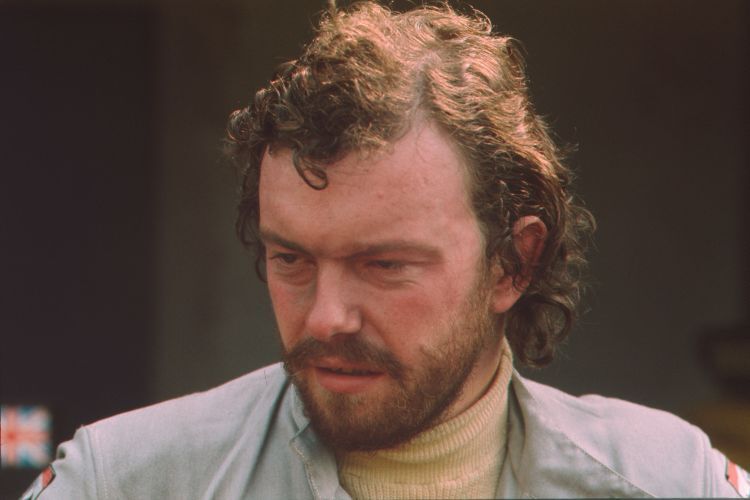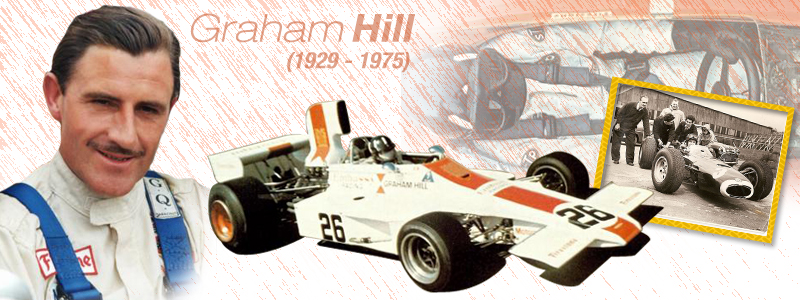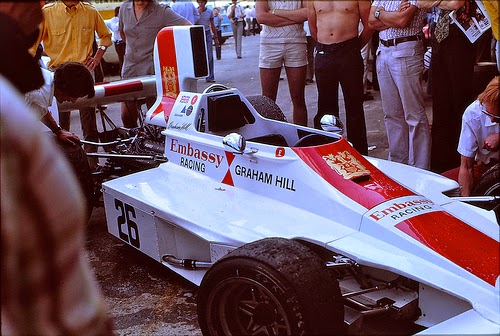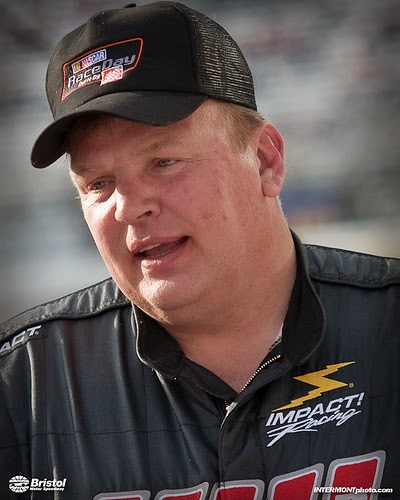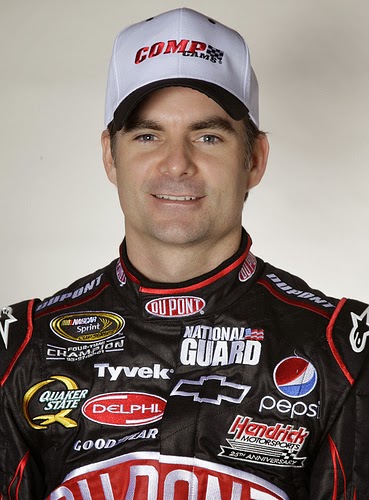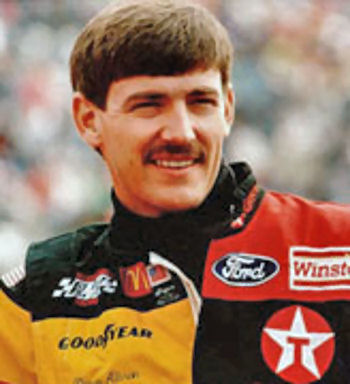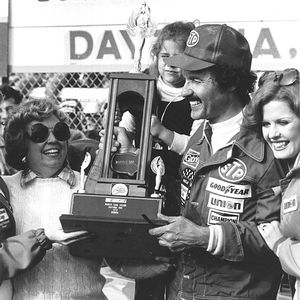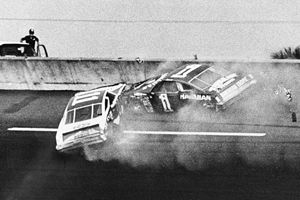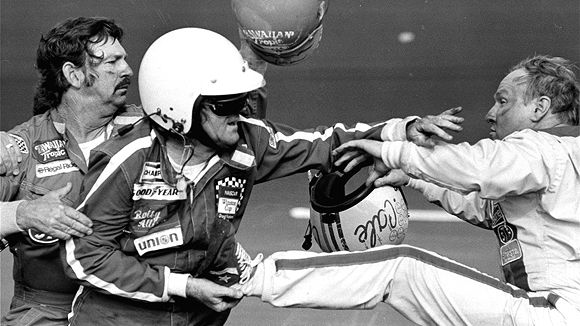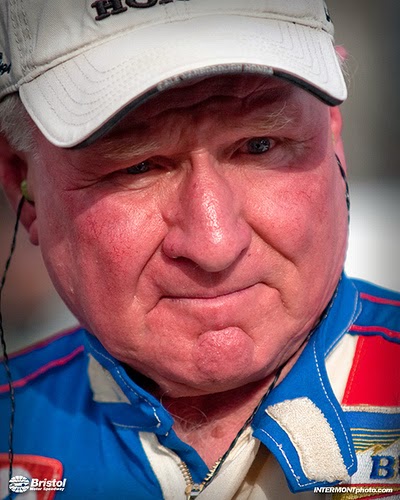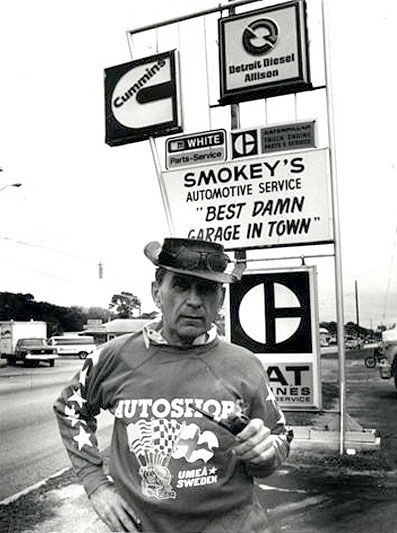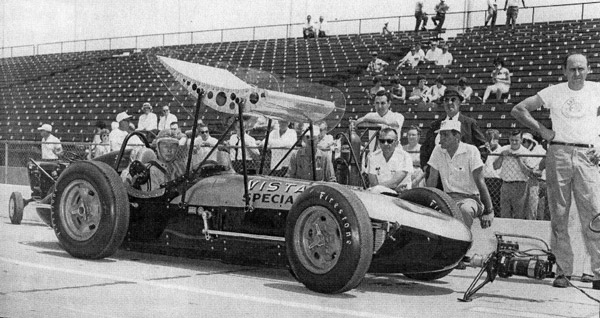March 18, 1937 – August 19, 1975
Mark Donohue
Born in Haddon Township, New Jersey, USA.
At the age of twenty-two, while a senior at Brown University in Providence, Rhode Island, Donohue began racing his 1957 Corvette. He won the first event he entered, a hillclimb in Belknap County, New Hampshire. He graduated from Brown in 1959 with a bachelor's degree in mechanical engineering.
Donohue won the SCCA national championship in an Elva Courier in 1961. An experienced race driver named Walt Hansgen recognized Donohue's ability and befriended him, eventually providing an MGB for Donohue to race at the 1964 Bridgehampton 500-mile SCCA endurance event, which he won. Hansgen arranged for Donohue to become his teammate in 1965, co-driving a Ferrari 275 at the 12 Hours of Sebring endurance race, which they finished in 11th place. That year, Donohue also won two divisional championships: in SCCA B Class in a GT350 and in SCCA Formula C in a Lotus 20B.
Donohue was hired On March 29, 1964 by Jack Griffith as Design Engineer for the Griffith, née TVR Grantura Mk III, powered by a Ford 289 cid V8 engine. During his stay at Griffith Mark drove the Griffith-owned Shelby 289 Cobra making his mark on the SCCA circuit. In 1966, thanks to his friendship with Hansgen, word quickly spread to the Ford Motor Company about the young driver. Ford immediately signed Donohue to drive one of their GT-40 Mk II race cars campaigned at the 24 Hours of Le Mans by the Holman & Moody racing team. Le Mans proved frustrating for Donohue. Hansgen died while testing the GT40 in preparation for Le Mans so Donohue partnered with Australian Paul Hawkins. Donohue and Hawkins only completed twelve laps due to differential failure and finished 47th. Earlier that year, co-driving with Hansgen, Donohue finished third at the 24 Hours of Daytona and second at the 12 Hours of Sebring.
At Hansgen's funeral, Roger Penske spoke to Donohue about driving for him. In his first race for Penske, at Watkins Glen in June 1966, Donohue qualified well but crashed the car at the top of a hill, destroying the car.
Donohue was invited back to Le Mans by Ford in 1967. Ford had developed a new GT, the Mark IV. Donohue co-drove in the #4 yellow car with sports car driver and race car builder Bruce McLaren for Shelby American Racing. The two drivers disagreed on many aspects of racing and car setup, but as a team were able to muster a fourth-place finish in the endurance classic.
In 1967, Penske contacted Donohue about driving Penske's brand new Lola T70 spyder in the United States Road Racing Championship.(photo credit: Mark Donohue - 1967 Lola T70 Mark 3 via photopin (license))(Mark Donohue - 1967 Lola T70 Mark 3)Donohue dominated the 1967 United States Road Racing Championship, driving a Lola T70 MkIII Chevrolet for Roger Penske. Donohue raced in seven of the eight races that year, winning six and finishing third at the Laguna Seca Raceway round behind Lothar Motschenbacher and Mike Goth. In 1968, Donohue and Penske returned to defend their USRRC championship with the McLaren M6A Chevrolet. Donohue dominated the series, even though he suffered three DNFs during the season due to mechanical problems.
Donohue began his Trans-Am series campaign in 1967, winning three of twelve races in a Roger Penske-owned Chevrolet Camaro. In 1967 and 1968, Trans-Am schedule included the 24 Hours of Daytona and the 12 Hours of Sebring. Donohue finished fourth at Daytona and won the Trans-Am class at the 12 Hours of Sebring.
1968 would be a banner year for Donohue in the Trans-Am series, as he successfully defended his 12 Hours of Sebring victory by partnering with Craig Fisher and driving his Penske Chevrolet Camaro to victory. Donohue went on to win 10 of 13 races, a Trans-Am series record which would stand until Tommy Kendall went 11 for 13 in the 1997 Trans-Am championship, winning the first 11 races that year in his All-Sport liveried Mustang.
During their enormous success in Trans-Am, Roger and Mark would begin to experiment with their Camaros. They discovered that dipping a car in an acid bath would eat away small amounts of metal, which in turn made the car incrementally lighter, and allowed it to be driven faster around the track. The 1967 Z-28 won its last race by lapping the entire field. During a post-race inspection, race stewards discovered that the car was 250 pounds lighter than the 2800-pound minimum weight requirement. Donohue was about to have his race victory taken away for cheating, but Roger Penske stepped in. Penske warned that any disqualification would have the potential of motivating Chevrolet to pull all support for the Trans-Am series. After considering the potential consequences, the race stewards allowed Donohue's victory to stand, but the rules for the 1968 season incorporated a change whereby all cars would be weighed during the technical inspection before the race. Penske and Donohue did not stop acid-dipping after this, however. Continuing the practice of reducing weight allowed them to place weights of certain sizes strategically in specific locations within the car, thus helping to balance the car while being driven on the limit. They continued to use the "lightweight" car in 1968, at the Sebring 12-hour race. They changed the grille and taillight to the 1968 model, and then painted both cars identically. They sent the legal weight car through the technical inspection with the number 15 and again with the number 16 on it. Then they put both cars in the race, number 15 and 16, one car being 250 pounds lighter. They won the race, finished 3rd overall, and went on to win 10 out of 13 races that year.
In 1969, Penske and Donohue raced in their first Indianapolis 500, where Donohue finished seventh, winning the rookie of the year award. Donohue raced at Indianapolis each year following, finishing second in 1970 and 25th in 1971.
In 1970 new Javelin team owner Roger Penske, and driver Mark Donohue, would breathe new life into the AMC team. Donohue drove the Javelin to three victories and finished second overall in the manufacturer’s championship, and missed the driver's championship by only two points. In 1971 Donohue won the final six races in a row, and seven out of nine, to become the Trans-Am Champion. In the final race of the season, all three Javelins finished in 1st, 2nd and 3rd places making AMC the season winner among all manufacturers. Donohue raced in several NASCAR Grand American races, a NASCAR pony car division from 1968 until 1971.(Photo; www.pinterest.com)In the 1972-1973 season, driving an AMC Matador for Penske Racing in NASCAR's top division, the Winston Cup Series, Donohue won the season-opening event at Riverside in 1973. That race was Penske's first NASCAR win in a long history of NASCAR participation and remains to this day, the last non-regular (non-full schedule) driver (road course ringer) to win a NASCAR Winston Cup road race.
(1972 McLaren Offenhauser Indy Car - Alex Lloyd driver)![]() (photo credit: #66 1972 McLaren Offenhauser Indy Car via photopin (license))Donohue won the 1972 Indianapolis 500, driving for Roger Penske. He finished the race in his McLaren-Offy setting a record speed of 162 mph, which would stand for twelve years. The victory was the first for Penske in the Indy 500.
(photo credit: #66 1972 McLaren Offenhauser Indy Car via photopin (license))Donohue won the 1972 Indianapolis 500, driving for Roger Penske. He finished the race in his McLaren-Offy setting a record speed of 162 mph, which would stand for twelve years. The victory was the first for Penske in the Indy 500.
Between 1972 and 1973, Penske Racing was commissioned by Porsche to assist with development of the 917/10. Donohue extensively tested the 917-10, offering up his substantial engineering knowledge to the Porsche engineers in order to design the best possible race car to compete in the Can-Am series. During testing of the 917-10 at Road Atlanta, Donohue had recommended larger brake ducts to the Porsche engineers, in order to provide more efficient cooling, and thus less fade and degradation as a race wears on.
The Porsche engineers obliged, but in doing so, caused the new brake ducts to interfere with the bodywork closure pins, which attach the bodywork to the car. Coming out of turn seven, the rear bodywork flew off the car at approximately 150 mph (240 km/h), causing the car to become extremely unstable. The car lifted off the ground and tumbled multiple times down the track. The front of the car was completely torn away, leaving Donohue, still strapped to his safety seat, with his legs dangling outside the car. Amazingly, Donohue only suffered a broken leg. George Follmer, Donohue's old Trans-Am teammate, resumed testing the 917-10 while Donohue was recuperating. In classic Donohue style, Donohue said of Follmer testing his car "It just doesn't feel right. Seeing another man driving your car, a car you know so well. I imagine it must feel like watching another man in bed with your wife".
Porsche, Penske, and Donohue quickly started the development of the 917-30, complete with a reworked aerodynamic "Paris" body and a 5.4-liter turbocharged Flat-12 engine whose output could be adjusted between approximately 1100 and 1500 bhp by turning a boost knob located in the cockpit. During the development of this motor, the German Porsche engineers often asked Donohue if the motor finally had enough power. His tongue-in-cheek answer was "it will never have enough power until I can spin the wheels at the end of the straightaway in high gear."
Donohue set the world closed-course speed record driving the Porsche 917-30 at the Talladega Superspeedway in Talladega, Alabama on August 9, 1975. His average speed around the 2.66-mile high-banked oval was 221.120 mph (355.858 km/h). Donohue held the world record for eleven years, until it was broken by Rick Mears at Michigan International Speedway.(Photo; www.flickr.com)The 917-30 is referred to, erroneously, as "The Can-Am Killer" as it dominated the competition, winning every race but one of the 1973 Can-Am championship, however, the SCCA imposed fuel limitations for all Can-Am races due to the existing Arab Oil Embargo. Because of this, Porsche and McLaren withdrew from the series. It generally is considered one of the most powerful and most dominant racing machines ever created.
Donohue raced in the inaugural IROC series in 1973/74, racing identical, specially-prepared Porsche RSRs. Of the four-race series, Donohue won the first and third of three races at Riverside and the final race of the year at Daytona. The only person to beat Donohue was his former Penske Trans-Am teammate, George Follmer. In winning the first IROC championship, Donohue beat the best-of-the-best racing drivers of that era from all of the major championships, such as Denny Hulme, Richard Petty, A.J. Foyt, Emerson Fittipaldi, Bobby Allison, David Pearson, Peter Revson, Bobby Unser, and Gordon Johncock.
The pressures of racing and designing the car took their toll on Donohue. Donohue announced that he would retire from racing after the 1973 Can-Am season. In addition, the horrific events at the 1973 Indianapolis 500 and the subsequent death of his friend, Swede Savage, pushed him to quit. His retirement was short-lived, however, as he was lured back to full-time competitive driving by Roger Penske when Penske formed a Formula One team, Penske Cars Ltd, to compete in the final two events of the 1974 Formula One World Championship, and to continue competing in 1975 with the new Penske PC1.
Donohue previously had debuted in Formula One on September 19, 1971 with a Penske-sponsored McLaren at the Canadian Grand Prix at Mosport Park, finishing on the podium in third place. After being lured out of retirement by his former boss, Penske, Donohue returned to Formula One, entering into the final two races of the 1974 Formula One season. Donohue finished in 12th place at the Canadian Grand Prix, but failed to finish at the United States Grand Prix.
A full-on assault of the 1975 Formula One season was planned. The 1975 season turned out to be a difficult one for Donohue and Penske. Donohue was able to muster 5th place finishes at the Swedish Grand Prix and the British Grand Prix, but the new Penske PC1 chassis proved problematic, as evidenced by three retirements in the first six races. At the Austrian Grand Prix, Donohue's career, along with Roger Penske's Formula One aspirations, would take a tragic turn. (photo credit: Mark Donohue driving March 751 via photopin (license))(Mark Donohue driving March 751)Midway through the 1975 F1 season, Penske abandoned the troublesome PC1 and started using the March 751. During a practice session for the race, Donohue lost control of his March after a tire failed, sending him careening into the catch fencing at the fastest corner on the track, Vöest Hügel. A track marshal was killed by debris from the accident, but Donohue did not appear to be injured significantly. It is said that Donohue's head struck either a catch fencing post or the bottom of the wood frame for an advertising billboard located alongside of the racetrack. A headache resulted, however, and worsened. After going to the hospital of Graz the next day, Donohue lapsed into a coma from a cerebral hemorrhage and died on August 19, 1975.
In 2003, in commemoration of Penske Racing's 50th NASCAR win, Nextel Cup driver Ryan Newman drove a Dodge Intrepid painted to resemble Donohue's 1973 AMC at the fall Rockingham, North Carolina, race. Penske's first NASCAR win came at the hands of Donohue.
Roger Penske's new Penske Racing complex in Mooresville, North Carolina is decorated with various murals of Donohue and his racing cars, most notably the AMC stock car and the various Porsche prototypes that Donohue drove through his career.
Mark Donohue was inducted into the International Motorsports Hall of Fame in 1990 and the Sports Car Club of America Hall of Fame in 2006.
Mark Donohue chronicled his entire racing career in the book, The Unfair Advantage. The book documents his career from his first races to his final full season of racing the year before he was killed. This was not merely a celebrity autobiography, but a detailed, step-by-step record of the engineering approach he took to getting the absolutely highest performance from every car he drove, always looking for that elusive "unfair advantage". Donohue along with Penske, were pioneers in many rights, some as notable as the use of a skidpad as a tool for developing and perfecting race car suspension designs and setups. The book told how Donohue learned to exploit the antilock braking system and the powerful turbocharged engine of several prototype Porsches, as well as how he learned from various mishaps, including a near-fatal crash. Penske and Donohue also improved upon a process called "acid dipping" when racing in the 1967 and 1968 Trans-Am series, as discussed above. The book was published shortly before Donohue's death.
The book was re-released in 2000 by Bentley Publishers. It includes information and additional photography that was not available before the first edition was published, but understandably had few new events to describe, aside from the author's death.
Donohue's racing tradition is carried on by his son, David Donohue, a successful road racer in his own right. He currently races a Daytona Prototype Porsche Riley for Brumos Racing in the Grand-Am racing series, who won the 2009 Rolex 24 Hours at Daytona.








